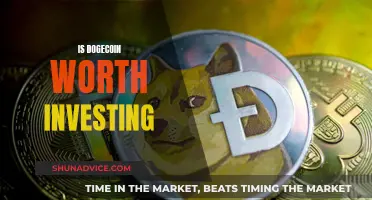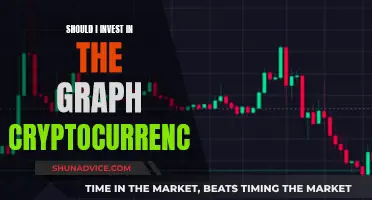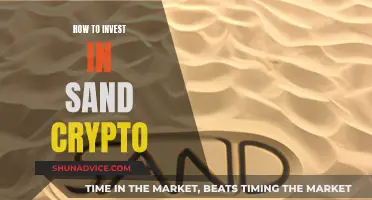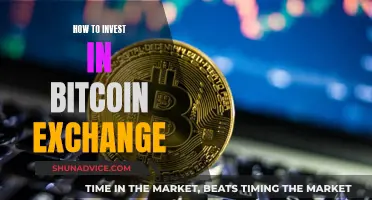
The cryptocurrency market is known for its extreme volatility and unpredictability. Despite a history of upswings and downswings, top cryptocurrencies have performed well for patient, long-term investors.
Bitcoin and Ethereum are the most popular cryptocurrencies, but there are thousands of others to choose from.
- Bitcoin (BTC)
- Ethereum (ETH)
- Tether (USDT)
- Binance Coin (BNB)
- Solana (SOL)
- U.S. Dollar Coin (USDC)
- XRP
- Dogecoin (DOGE)
- Toncoin (TON)
- Tron (TRX)
- Cardano (ADA)
- Avalanche (AVAX)
- Chainlink
- Polygon (MATIC)
What You'll Learn

Bitcoin and Ether: the two best cryptocurrencies to buy
Bitcoin and Ether are the two best cryptocurrencies to buy. They are the two leading cryptocurrencies and have continued their bullish momentum in 2024. Both have risen in popularity, with Bitcoin being the first cryptocurrency and Ether offering more utilitarian value through its ecosystem of decentralised apps.
Bitcoin
Bitcoin's value rests mostly on its status as the first cryptocurrency and as an alternative to fiat currency. It is a blockchain-based, decentralised digital currency powered by a network of users that allows financial transactions without relying on a central authority or intermediary. Bitcoin is secured by cryptography, with transactions verified by a process known as mining in which users compete to verify transactions by solving complex mathematical puzzles using powerful computers. This verification method is known as proof-of-work, or PoW.
Bitcoin transactions are permanently recorded on a public ledger that can never be changed or manipulated in any way. There is a limited supply of Bitcoin, capped at 21 million, and its anti-inflation properties make it an effective store of value in the long term.
Ether
Ethereum is a blockchain platform created to support smart contracts and secure financial transactions. Its native cryptocurrency is Ether. Smart contracts are software that allows decentralised apps, or dApps, to run automatically on a blockchain when a set of predetermined conditions are met. The Ethereum network includes dApps for gaming, gambling, socialising, and even decentralised finance, or DeFi. Most non-fungible tokens, or NFTs, are also based on the Ethereum network.
The Ethereum network is decentralised and operates on a network of thousands of computers around the world. In 2022, the Ethereum network transitioned from an energy-intensive PoW verification system to a proof-of-stake, or PoS, model. Ether does not have a hard supply cap, but supply is managed through a process known as burn.
Bitcoin and Ether compared
While there are very few similarities between Bitcoin and Ether beyond the fact that they are both popular cryptocurrencies that operate on decentralised blockchain networks, there are some key differences to note.
Bitcoin's primary purpose is to be a digital currency and an alternative to fiat currencies like the US dollar, which can be easily exchanged for goods and services. On the other hand, Ether's primary purpose is to serve as a platform to run smart contracts and other dApps, and it is simply the native cryptocurrency used to facilitate transactions on the Ethereum network.
Bitcoin has a finite supply capped at 21 million, while Ether has a theoretically infinite supply. Bitcoin's future price performance will likely depend on its adoption as a legitimate global currency and its popularity as an inflation hedge and store of value for investors. In contrast, Ether's future price performance will likely depend more on the popularity of the Ethereum network and the growth of dApps and smart contracts.
Investing in Bitcoin and Ether
Investors can buy Bitcoin and Ether directly on popular cryptocurrency exchanges such as Coinbase, Gemini, and eToro. They can also be purchased via a brokerage account with Robinhood, Interactive Brokers, TradeStation, or other platforms that support crypto trading.
Both Bitcoin and Ether have futures contracts that trade on the Chicago Mercantile Exchange. There are also several Bitcoin and Ether ETFs that hold futures contracts, such as the ProShares Bitcoin Strategy ETF (BITO) and the VanEck Ethereum Strategy ETF (EFUT).
As of January 2024, investors can also buy spot Bitcoin ETFs that hold the cryptocurrency itself rather than futures contracts. Some examples include the ARK 21Shares Bitcoin ETF (ARKB) and the Fidelity Wise Origin Bitcoin Trust (FBTC).
While several firms have applied to launch spot Ether ETFs, none have been approved by the SEC as of May 2024.
Final Thoughts
While Bitcoin and Ether are the two best cryptocurrencies to buy, it is important to remember that they are still prone to extreme price volatility. Both cryptos have experienced steep price climbs and nosedives, and investing in them requires a high-risk tolerance.
Andrew Tate's Crypto Investments: Does He Believe in It?
You may want to see also

Solana: a blockchain with utility in mind
Solana is a blockchain platform that supports decentralised applications (dApps). It is often referred to as an 'Ethereum killer' because it performs many more transactions per second than Ethereum, and charges lower transaction fees.
Solana runs on a unique hybrid proof-of-stake and proof-of-history mechanism to process transactions quickly and securely. Its native token, SOL, has risen in value since its launch in 2020. Excluding stablecoins, Solana is the fourth-largest cryptocurrency in the world, with a market capitalisation of around $76 billion as of June 2024.
Solana is known for facilitating the easy creation of dApps, but it is also faster, has lower fees, and is more easily scalable than its rivals. It has attracted a lot of attention to its platform through the popularity of Solana meme coins, which are easy and cheap to create and trade. Dogwifhat (WIF) and Bonk (BONK) are two of the most popular Solana meme coins.
Solana is one of the first blockchains to partner with a major financial institution to process payments – in this case, Visa. Other companies that have projects on Solana include Meta, Stripe, Shopify and Google.
However, Solana has been prone to network outages, which undermines its credibility. If Solana wants to live up to its hype as an 'ethereum killer', its stability must improve.
Cryptocurrency Investing: Risks, Rewards, and the Future of Money
You may want to see also

Avalanche: a blockchain with ambitious goals
Avalanche is a layer-one blockchain that functions as a platform for decentralized applications and custom blockchain networks. It is one of Ethereum's rivals, aiming to unseat Ethereum as the most popular blockchain for smart contracts. Avalanche seeks to provide a higher transaction output of up to 6,500 transactions per second, while not compromising scalability. This is in contrast to other blockchains such as Bitcoin, which claimed around 7 TPS in 2023.
The Avalanche network consists of three individual blockchains, each serving a distinct purpose: the X-Chain, C-Chain, and P-Chain. This is radically different from the approach taken by Bitcoin and Ethereum, which use a single blockchain to validate all transactions. The division of tasks across these three blockchains allows Avalanche to achieve higher throughput without compromising on decentralization.
The X-Chain is used to create and exchange the native AVAX tokens and other assets, following a set of standardized rules. The C-Chain hosts smart contracts and decentralized applications, with its own Avalanche Virtual Machine, allowing developers to fork EVM-compatible DApps. The P-Chain coordinates network validators, tracks active subnets, and enables the creation of new subnets.
Avalanche's unique architecture enables it to solve the blockchain trilemma, which posits that blockchains cannot achieve a sufficient degree of decentralization at scale, leading to high gas fees. By designing three interoperable blockchains, Avalanche improves its interoperability with other blockchains and enables higher transaction throughput.
Avalanche was launched by Ava Labs, founded by Cornell University professor Emin Gün Sirer, and Cornell University computer science PhDs Kevin Sekniqi and Maofan "Ted" Yin. Gün Sirer is a veteran in cryptographic research, having designed a conceptual peer-to-peer virtual currency six years before the release of the Bitcoin whitepaper. He was also involved in work on Bitcoin scaling solutions and research on Ethereum before the infamous "The DAO" hack in 2016.
Avalanche completed its initial coin offering in 2020 in under 24 hours, raising $42 million. The total supply of AVAX is 720 million, with a market capitalization of almost $14 billion as of June 2024. AVAX can be used to pay transaction fees and can be staked to secure the network, with an annual reward of 11.57%.
Avalanche's subnets feature allows users to deploy their own mini-blockchains on top of its network. This feature is particularly attractive to mainstream commercial entities and individuals who want their own blockchains. If Avalanche can successfully realize this ambition, it could emerge as a longer-term winner in the blockchain space.
Taboo Coin: Worthy Investment or Risky Business?
You may want to see also

Polygon: a scaling platform for Ethereum
Polygon (MATIC) is a layer-2 scaling solution for the Ethereum blockchain. It was initially developed to address issues with Ethereum network congestion and traffic. Ethereum is a blockchain that allows developers to create their own cryptocurrency and deploy smart contracts. However, it has faced challenges with slow transaction speeds. This is where Polygon comes in.
Polygon uses three layers: Ethereum, Heimdall, and Bor. The Bor layer is responsible for compiling transactions into blocks and creating periodic snapshots of the blockchain. The validators on this layer are called block producers. The blocks are then aggregated by the Heimdall layer, which validates all the blocks created since the last snapshot from the Bor layer. Finally, a Merkle tree is created and the Merkle root is published to the Ethereum mainnet.
Benefits of Polygon
Polygon's multi-chain system improves the speed of transactions and verification for the Ethereum network. It also provides several other solutions for developers, including smart contracts, decentralized applications (dApps), and support for non-fungible tokens (NFTs).
Risks of Investing in Polygon
While Polygon currently offers faster transaction speeds than Ethereum, future improvements to the Ethereum network could eventually result in faster transaction speeds, eliminating Polygon's primary advantage. Additionally, Polygon's token, MATIC, suffered a 70% loss in value in 2022 and is still far from its late 2021 highs.
Polygon is a promising scaling platform for Ethereum, offering faster transactions and support for various applications. However, investors should be aware of the risks associated with the potential for Ethereum to overtake Polygon in terms of transaction speeds and the volatility of the MATIC token.
Algo Coin: A Worthy Investment?
You may want to see also

Cardano: a proof-of-stake blockchain
Cardano is a proof-of-stake blockchain and one of the largest blockchains to successfully run that more energy-efficient protocol. It was founded in 2017 by Charles Hoskinson, who was also a co-founder of Ethereum. Cardano's blockchain was created through extensive experimentation and peer-reviewed research, with over 120 papers written on blockchain technology by the researchers behind the project.
Cardano's blockchain is designed to be more functional, with the ability to facilitate dApp development and verifiable smart contracts. Its native cryptocurrency, ADA, is used to run dApps, and can be earned as a reward by users who stake ADA to help verify and facilitate transactions.
Cardano has a smaller footprint than some other cryptocurrencies, which is appealing to investors as it takes less energy to complete a transaction. This means transactions are faster and cheaper. Cardano has also launched an upgrade that increased functionality, enabling smart contract deployment, and another upgrade called Vasil, which improved the blockchain's scalability.
Cardano is currently the tenth-largest cryptocurrency by market value, with a market cap of over $10 billion as of July 2023. Cardano's non-fungible token protocol is the world's second-largest. However, it may struggle to compete with larger cryptocurrencies, which could lead to fewer adopters and developers.
Libra Coin: A Guide to Investing in the Crypto
You may want to see also
Frequently asked questions
The top 3 cryptocurrencies by market capitalisation are Bitcoin, Ethereum and Binance Coin.
The best long-term cryptocurrency investments are the more mature coins like Bitcoin and Ethereum, which have longer track records, larger market caps and more adoption by major financial institutions.
The value of cryptocurrencies tends to fluctuate a lot and is extremely volatile, making investing in cryptocurrency risky. Cryptocurrencies are not backed by revenue-generating companies or other assets, and there is a low barrier to entry to creating a new crypto, which is why you see new currencies pop up all the time.
Cryptocurrencies trade on exchanges, similar to stocks. But not all exchanges and brokerages support cryptocurrencies, especially altcoins. Leading crypto brokers include SoFi and Robinhood. Popular cryptocurrency exchanges include Binance and Coinbase.







